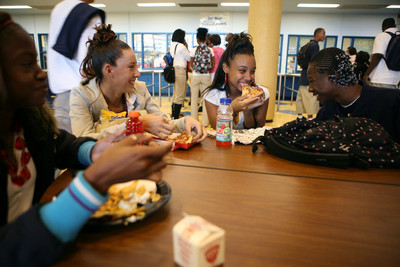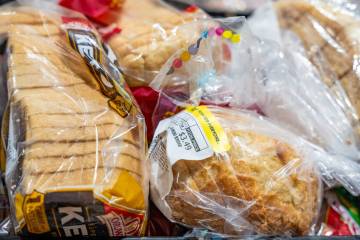High school lunchrooms a picture of social cliques
The students stream into the lunchroom of Cheyenne High School and, like carrier pigeons off to a specific somewhere without knowing why, hurry to their tables.
There, they meet with BFFs (best friends forever), BFFLs (best friends for lunch) and even the occasional BFFLBITHTSATJDs (best friends for lunch because if they had to sit alone they'd just die) at tables they probably sat at yesterday, probably will sit at tomorrow and may well sit at until they fling mortarboards into the air at commencement.
Pretty routine stuff, on the surface. But if you dig deeper -- deeper than most people, admittedly, think worth looking -- it's fascinating, the collection of norms, customs and unwritten rules that govern the high school lunchroom.
Most frightening of all is that, no matter how distant your own school days are, it's all so frighteningly familiar.
The anthropology of the high school lunchroom. Somewhere out there, there's grant money to be had.
• • •
"You got your freshmen, ROTC guys, preps, J.V. jocks, Asian nerds, cool Asians, varsity jocks, unfriendly black hotties, girls who eat their feelings, girls who don't eat anything, desperate wannabes, burnouts, sexually active band geeks ..."
(The high school caste system as defined in "Mean Girls," written by Tina Fey.)
• • •
Cheyenne Principal Jeff Geihs, who's pulled his share of lunchroom monitor duty over the years, notes that lunch period is a deceptively vital aspect of the school day.
As the only truly free -- read: no assigned seats -- period of the day, lunchtime represents an opportunity to build school camaraderie and a time for students to socialize and just generally decompress from the rigors of the school day.
"I can remember my high school days and college days," Geihs says, "and I looked forward to that unstructured time."
One big change Geihs has noticed since his own high school days at Bishop Gorman High School: Gorman actually had a designated smoking area for students at lunchtime.
Now, he says, "we don't even let our staff smoke at school."
But pretty much everything else would seem familiar to grads of any generation. There remains, for instance, that fervent first-day-of-school prayer that somebody you know will share the same lunch period.
That's vital, notes freshman Carolyn Rovere. "It's like, you want to fit in."
Brenda Caszatt, a dean at Cheyenne, notices it particularly among transfer students and new students.
"When the ninth-graders come in at the very beginning of the year, they almost seem a little lost," she says. "They're trying to find people they know from their middle school and kind of catch up with. Then, if they see somebody they knew from the past, then I think they feel a little bit relieved."
Friendships even can begin from that first-day dance, as students who know each other only slightly bond over their daily midday meal.
"You meet friends through other friends," says sophomore Mariah Johnson. "Like, you sit with your friend and other people come and sit with you."
But none of this was a problem for sophomores Diana Ceniceros and Karen Deltoro.
"We've known each other since middle school," Ceniceros says, and Deltoro adds that they checked schedules even before their first lunch period to make sure they shared it.
And when there's nobody you know? "You would just look for somebody who is approachable, who looks nice," says sophomore Arielle Edwards.
Lunchroom friends don't even necessarily have to be friend-friends. They could just be people you lunch with but don't socialize with outside of school.
But that's no different than the adult world, notes Heidi Swank, an assistant professor of anthropology and ethnic studies at the University of Nevada, Las Vegas.
Even at work, notes Swank, "you have people you eat lunch with and may interact with in the office but not outside the office."
Swank recalls that, even during her own high school days in the '80s, "where you sit is a big question."
Even today, athletes tend to sit with athletes, cheerleaders with cheerleaders, artists with artists, skateboarders with skateboarders and whomever with whomever in any other combo you could imagine.
At her own school, one table during fall semester even was comprised of "the tannest people," Swank says. "It was an unspoken competition in my school in Wisconsin to have the darkest tan."
On the other hand, Geihs says that, unlike during his own school days, tables don't tend to be delineated along racial, cultural or ethnic lines.
"I'm pretty proud of the fact that these kids seem to desegregate themselves," he says. "We don't manufacture that."
Junior Ben Villegas notes that the table groupings pretty much break down along shared interests more than anything. "It's just people who have stuff in common with each other," he says.
It's no mystery, Swank agrees. "Humans are just social beings. This is part of who we are as human beings."
Weirdly enough, table groups develop early in the school year, Geihs says, typically "by the second week of school."
After that, they don't change very much, Caszatt says. "I would say that nine times out of 10, the same kids sit at the same table every single day.
"I think that's just what they're used to," she says. "They're used to their routine and hanging out with their friends, and everybody knows where to meet so they're at the same table every day."
Sophomore Deltoro notes that the makeup of a table may change if, say, a new student joins an established group. But, Deltoro and Ceniceros agree, new people are apt to join existing groups and it's unlikely that a new member will cause an entire table group to re-form.
What's the criteria for being accepted at an existing table? Mostly, Ceniceros says, "if they get along" with its existing members.
Swank notes that leaving an old group behind to join a new one would involve personal risk.
"If you have kind of developed a way of having lunch together that's set within your group, to go to another group would mean that you'd have to be able to incorporate your ways of having lunch within that (new) specific context," she says.
Members of any group develop practices -- figures of speech, in jokes, ways of dressing -- that reinforce the group, Swank notes. "All of those things seem to pull you together as a group."
So, moving to another group would mean learning a new set of such ways of interacting, Swank says, as well as giving up the status one has gained in the old group for the uncertain status in a new one.
So, next time you ask your kid about how the school day went, ask about lunch, too. It could be revealing.
But don't expect us to share any of that grant money.
Contact reporter John Przybys at jprzybys@ reviewjournal.com or (702) 383-0280.



















